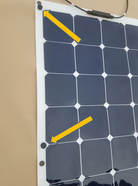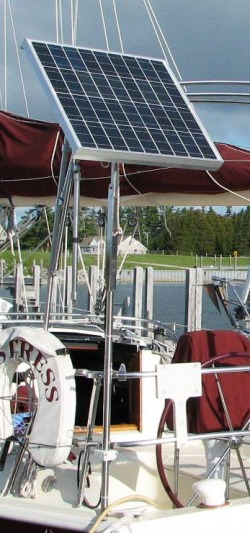 Solar Panel Attached to Canvas Bimini Using Rare Earth Magnets Solar Panel Attached to Canvas Bimini Using Rare Earth Magnets There may be times when it is desirable to mount flexible marine solar panels on a canvas bimini or dodger and be able to quickly and easily remove them. Our auxiliary solar panel mounting kit is designed for such an application. One of our business associates, Ed Foster, came up with a brilliant idea for a mounting system that does not require you to put holes in your beautiful bimini or dodger canvas - high power rare earth magnets. Very high power rare earth magnets (up to 20 pound pull strength per magnet) are ideal for temporary mounting of our flexible solar panels on a canvas bimini or dodger. Our rare earth magnet kit includes 8 or 12 magnets and adhesive to attach the magnets to the upper side of the solar panel. Quality magnets are triple coated with a nickel-copper-nickel or an epoxy-copper-nickel coating. These magnets are also available with a plastic or rubber coating. We are testing various designs to determine resistance to corrosion in a saltwater environment. This is the big unknown. Using the magnet mounting kit is easy. Attach magnets to each corner of the solar panel and optionally attach two near the center of larger flexible panels using the included double sided adhesive tape. Position the flexible marine solar panel on the bimini or dodger and attach a mating set of magnets on the underside of the canvas. Connect the solar panel to the solar system using an MC4 T-branch connector. Store the panel under a bunk when not in use. We tested a set of these magnets on a 110 watt flexible panel during 6 week cruise in the North Channel of Lake Huron during the summer of 2018. We were in heavy winds and the panel did not move a bit. The magnets held the panel secure and there was no air getting under the panel to lift it.
11 Comments
We are often asked about the impact of wind resistance on solar panels mounted on a pole when the boat is under sail or when it is blowing a “hooley” out there in heavy seas. This is a valid concern. Anytime you put something in the way of the wind on a boat there are bound to be consequences.
It is important to note that none of our customers to date have reported a problem with wind resistance nor have we had a problem on our test boats. Fortunately, an adjustable pole mounted solar panel offers numerous options to address wind resistance. Some of our customers have reported that they tilt their panel to a horizontal position in a blow to minimize wind resistance. Other customers have replaced the single nut and bolt that attaches the panel to the pole with a locking pin or lynch pin. In a blow, they simply pull the pin, unplug the panel and stow it down below. Other customers just leave the panel alone and don’t worry about it. The panel is usually tilted at a 30 to 45 degree angle to achieve optimum sun angle. This alone reduces wind resistance by over 50% relative to a panel in a vertical position perpendicular to the wind (not sure why a panel would ever be in a vertical position however). Also, it is important to consider that the boat is moving smoothly with the waves thus enabling a relatively even airflow over the panel. In addition, the panel can be rotated so achieve some potentially beneficial results. With the top of the panel tilted into the wind, the unit will tend to put a downward force on the stern. With the panel bottom into the wind, it will tend to put a lifting force on the stern. What is the weak point in the system in a heavy wind? Looking at the system as a unit, it is apparent that the pole, the tilt mechanism and the braces attaching the panel to the tilt mechanism are plenty strong. The brackets attaching the pole to the stern rail are plenty strong. Our tests have proven this to be a fact. The only remaining point of potential failure then is the stern rails. We have seen boats with very strong well anchored stern rails and boats with rather dubious stern rail anchoring systems. Each boat owner must assess the strength of the stern rails and determine their ability to support the stresses of a pole mounted solar system. It could be that lateral braces connecting the pole to the deck or to the bimini frame are necessary. The size of the panel is directly proportional to the amount of potential wind resistance. We recommend mounting a panel no larger than our 120-130 watt panel which measures approximately 49 X 32 inches on a boat with strong well designed stern rails. The Kyocera 85 watt panel measuring approximately 40 X 26 inches is ideal for our smaller panel system. See other blog entries for an analysis of the performance of this panel. The weather for our cruise in the North Channel of Lake Huron this year was excellent. It was warmer and sunnier than last year. Our Kyocera 85 watt solar panel performed very well. The following are some statistics:
Days cruising: 22 days Max power generation: 40 amp-hours Min power generation: 13 amp-hours Average power produced per day: 35 amp-hours Average power consumed per day: 51 amp-hours Our primary use of power was for the refrigerator/freezer. We ran a power deficit each day of about 16 amp-hours at anchor but with our 360 amp-hour battery bank, this not a problem. Moving on every 4 days or so gave the 75 amp alternator plenty of time to bring the batteries back up to charge. We spent the month of July in the North Channel in Northern Lake Huron north of the 45th parallel. We logged the output of our top-of-pole mounted 85 watt Kyocera solar panel and our daily power consumption. It was an unusually cloudy July. Here are some statistics.
Weather Mostly cloudy 7 days Partly cloudy 8 days Partly sunny 8 days Mostly sunny 7 days Power Generation Maximum power produced in a day was 38 amp-hours Minimum power produced in a day was 12 amp-hours Average power produced per day for the 30 day period was 25 amp-hours Power Consumption Average power consumed for the 30 day period was 46 amp-hours Our travel pattern was to stay at anchor for 2-3 days and then motor/sail to another anchorage. We connected to shore power one night. While we ran a power deficit of 21 amp-hours per day while at anchor, our high output 75 watt alternator quickly replenished our batteries on our travel days. We ran our refrigeration/freezer every day as well as our computer (chart plotting) and autopilot when underway. We found the combination of our 85 watt panel and our 75 watt alternator provided us with ample power for the trip. Solar panels provide an excellent solution for obtaining the electrical power needed to support on-board electrical systems. They are quiet, require little maintenance and are reliable.  Top-of-Pole Mount |
Categories
All
AuthorThomas Trimmer has been cruising with his Ericson 38 sailboat on the Great Lakes for over 20 years. He has pioneered the use of solar energy for wilderness cruising. He is continually designing and building equipment to simplify and enhance the cruising experience. Archives
April 2024
|
Efficiently Powering Your Vessel/Van. Call/email/chat any time, we're happy to help you work through designing your solar system.
Home Page Solar Panels Mounting Kits Product Page Marine Solar Systems Gallery of Installations Customer Comments Contact Us
Call 248 705-8337 or email [email protected]
Article On How To Size Your Solar Panels For Your Boat
Customer Reviews Return Policy Privacy Policy Shipping Times/Rates
Home Page Solar Panels Mounting Kits Product Page Marine Solar Systems Gallery of Installations Customer Comments Contact Us
Call 248 705-8337 or email [email protected]
Article On How To Size Your Solar Panels For Your Boat
Customer Reviews Return Policy Privacy Policy Shipping Times/Rates

 RSS Feed
RSS Feed